Blue ringed octopuses are some of the most venomous marine creatures in the world. These small members of the cephalopod family are also related to other octopus species, along with squid, cuttlefish, and nautilus. You can easily recognize these small octopuses because of the bright blue rings covering their bodies. These rings are a warning to predators that the animal is dangerous. Read on to learn about the Blue Ringed Octopus.
Description of the Blue Ringed Octopus
As far as extremely dangerous animals go, blue-ringed octopuses are pretty innocuous. Especially because they are no bigger than eight inches long! It is easy to tell that a lion, or even a lionfish, could possibly harm you. However, the pretty little octopus hiding in the tide pool could be just as dangerous. The primary warning that these little cephalopods give is their bright blue rings, which tells predators, “Stay away! I’m dangerous!”
Interesting Facts About the Blue Ringed Octopus
If you ever cross paths with one of these little beauties, it is important that you look, but don’t touch. Learn more about these potentially dangerous little creatures below.
- Venom vs. Poison – Unlike some marine species, which are poisonous when eaten, you don’t have to eat a blue ringed octopus for it to hurt you. This is because they are venomous not poisonous! If a blue ringed octopus bites you, it injects venom that quickly makes its way into your bloodstream.
- Variety – There is not one, not two, not three, but four different species of blue ringed octopus! Those are just the species that scientists have formally identified. Some suggest there may be as many as ten different species. The three most common are the greater blue-ringed octopus, the southern blue-ringed octopus, and the blue-line octopus.
- Very Dangerous – Tetrodotoxin is the venom that these octopuses use. This toxin is actually the same type found in pufferfish. If bitten, it is important to get to a hospital as soon as possible. One little octopus has enough venom to kill 26 adult humans!
Habitat of the Blue Ringed Octopus
Like most other octopus species, these creatures roam the seafloor in search of food. They prefer habitats with rocky crevices and similar landscapes to make their dens. Because of this, they are particularly fond of coral reefs and tide pools. Most of the time, you can spot these creatures in shallow waters, when you can spot them at all. Despite their colorful appearance, they have wonderful camouflage.
Distribution of the Blue Ringed Octopus
Each species of blue ringed octopus has a different home range. As a whole, scientists believe they live only in the Pacific and Indian Oceans. The lesser-known species are uncommon and difficult to locate and study. It is much easier to pinpoint the range of the more common species.
The greater blue-ringed octopus has a wide range, spreading from Australia to Sri Lanka, Japan, and Vietnam. The southern species has a much more restricted range, and is located only off the southern coast of Australia. Finally, the blue-lined species ranges only from New South Whales to Queensland.
Diet of the Blue Ringed Octopus
Because these creatures are quite small compared to other octopus, and even to other cephalopods, their diet is more restricted than their other cousins. For the most part, they eat small crabs and shrimp, as they are too small to pry open clams or other mollusks.
When given the opportunity, they will also finish off injured fish, but typically are not capable of capturing healthy ones. Once they have snagged a meal, they use an entirely different type of venom to incapacitate their prey.
Blue Ringed Octopus and Human Interaction
Aside from the occasional clueless diver, bites from these octopuses are usually pretty rare. While they will defend themselves, and should never be handled, they are not aggressive. In fact, most of the time, if you pass a blue-ringed octopus, you probably won’t even see it. They would rather hide than fight off a potential predator.
Unfortunately, like all reef-dwelling animals, humans are putting these creatures in danger. Climate change is extremely detrimental to reef communities, and pollution adds fuel to the flame. Coral reefs are dying off because of ocean acidification, and because waters are increasing in temperature.
Domestication
Humans have not domesticated this species in any way.
Does the Blue Ringed Octopus Make a Good Pet
No, blue ringed octopuses do not make good pets. Even if you never touch them, it just isn’t a good idea to have an animal that could kill you living in your home. See Pacific Octopus to learn more about how well octopuses can escape their tanks.
Blue Ringed Octopus Care
Like all octopuses, they can live in aquariums, but they have a very short lifespan. Any enclosure must be extremely well sealed to prevent escapes. You must also provide plenty of hiding places for the octopus to make its den. Finally, they thrive on a diet of small crustaceans. Aquariums successfully house these creatures from time to time.
Behavior of the Blue Ringed Octopus
Like most octopuses, these predators are solitary creatures. They remain within the safety of their dens during the day, and emerge at night to hunt for small prey. These creatures are masters of camouflage, and can easily hide in plain sight. However, when threatened they will turn bright yellow, and widen the blue rings that cover their skin. Some species can even flash the color of the rings as a warning!
Reproduction of the Blue Ringed Octopus
Male octopuses use a modified arm, called a hectocotylus, to deposit packets of sperm to the female. The female then uses the sperm packet to fertilize her eggs at her leisure. She will lay around 50 eggs, and incubates them under her arms. During this time, the female stops eating, and spends all her time protecting the eggs. Blue ringed octopuses are semelparous, which means they die after reproducing.

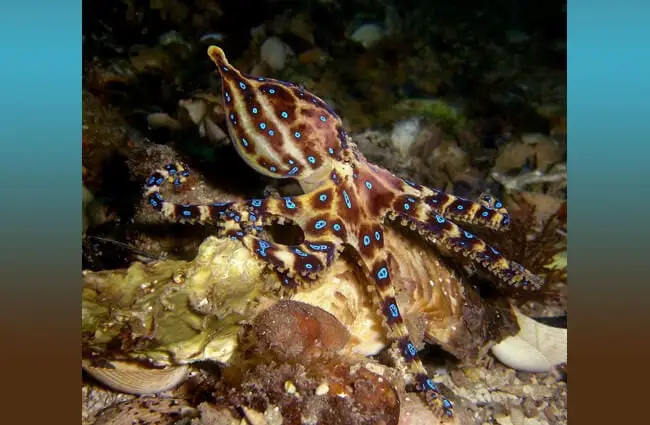
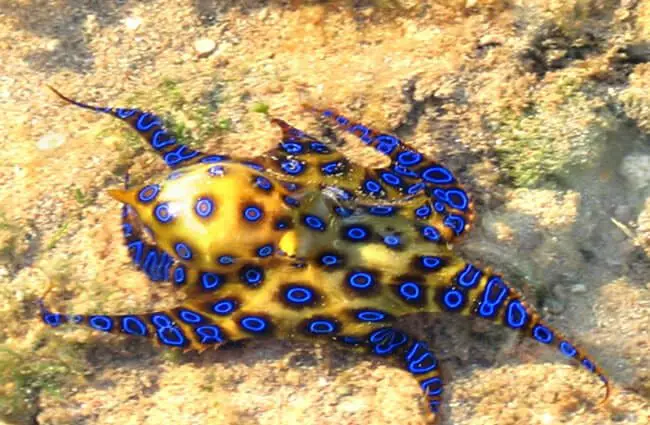
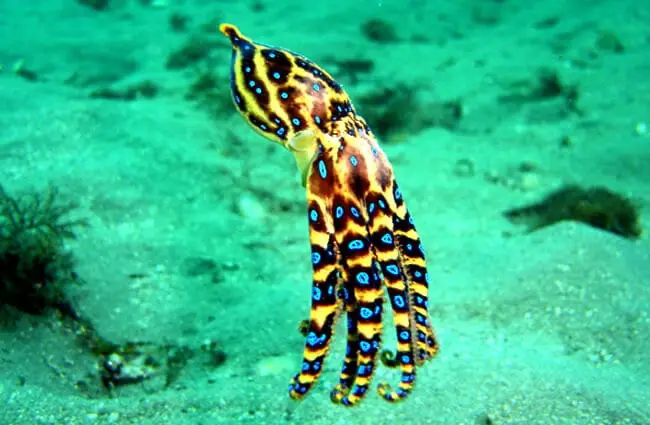








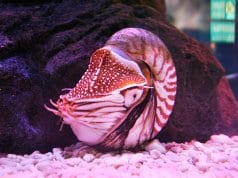
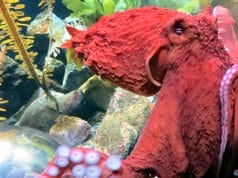










![Red Angus Closeup of a beautiful Red Angus cowPhoto by: U.S. Department of Agriculture [pubic domain]https://creativecommons.org/licenses/by/2.0/](https://animals.net/wp-content/uploads/2020/03/Red-Angus-4-100x75.jpg)

